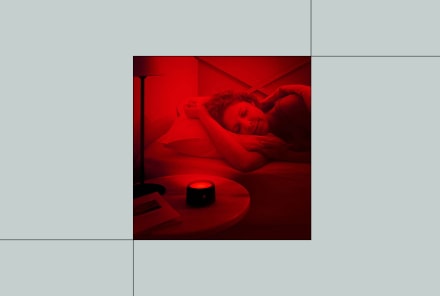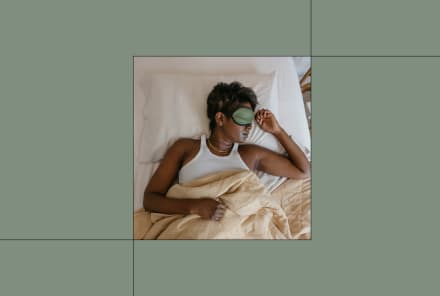Advertisement
Synesthesia 101: Definition, Causes + A Simple Test To Find Out If You Have It


Of all the phenomena of the brain, synesthesia is one that's equally fascinating and mysterious. Characterized by senses essentially overlapping (i.e., hearing and vision, or hearing and taste), here's what to know about synesthesia, signs of a synesthete, and a test to find out if you have it yourself.
What is synesthesia?
Synesthesia is a neurological phenomenon in which information meant to stimulate one of your senses stimulates several of your senses, explains neurologist Romila "Romie" Mushtaq, M.D., ABIHM.
"People who have synesthesia are called 'synesthetes,'" she notes, adding that the word "synesthesia" comes from the Greek words synth, which means "together," and ethesia, which means "perception."
As sleep and neurology expert Chris Winter, M.D., tells mbg, synesthesia is ultimately the sensory perception of experiencing a "crossing over" of your senses. "Certain words might elicit something within an individual that really has nothing to do with the word," he says for example, such as someone hearing the word "bounce" and seeing the color yellow in their mind's eye.
"Synesthetes can often 'see' music as colors when they hear it, and 'taste' textures like 'round' or 'pointy' when they eat foods. Another example of synesthesia is seeing the same color every time you see a certain number or hearing sounds with light motion," Mushtaq notes.
How common is it?
According to Mushtaq, synesthesia is seen in roughly 3 to 5% of the population, and in about 40% of those people, it's genetic. It's also significantly more common in women1 than men.
"Synesthesia is not considered a disease, nor is it associated with a higher rate of mental disorders," she explains, adding "Books and articles in the past have eluded to synesthesia being related to mental health disease, but research shows that there is no correlation between synesthesia and schizophrenia, psychosis, addiction, or any other mental health disease." There's also no clinical diagnosis for synesthesia.
One link that has been found in research, however, is synesthesia and autism. In one 2020 study2, researchers note that there may be higher rates of synesthesia among diagnosed individuals with autism. "Up to 20% of autistic individuals may experience synesthesia, and more research is currently being conducted to understand the correlation between the two," Mushtaq says.
Signs a person has synesthesia.
First, we'll break down a few common ways people experience synesthesia, though it's important to note synesthetes will experience their synesthesia differently, and may experience varied combinations of these signs. Then, we'll get into some other telltale characterizations.
- Seeing colors when you hear music
- Tasting something when you hear certain words
- Seeing colors when you see certain letters or numbers
- Feeling touch or other sensations when you see someone else experiencing that touch
- Feeling a physical sensation when you hear certain sounds
- Smelling something when you hear certain sounds
- Seeing colors when you smell something
On top of the way synesthesia presents for individuals, there are some other signs that indicate someone really is a synesthete. For one thing, with synesthesia, the sensory experiences are consistent (i.e., if the number seven "looks" green to a synesthete, it will always be green, even years later). Additionally, synesthesia happens unwillingly without having to control or even think about it.
What causes it?
The jury is ultimately still out on what causes synesthesia, with Mushtaq noting that it's not well understood. As aforementioned, synesthesia may be due to genetics in about 40% of the people, and they were simply born that way, but we're still not sure why it happens.
"In genetic cases, we see the brain has enhanced connections between different regions of the brain cortex associated with senses," Mushtaq tells mbg, adding, "There are also cases of synesthesia that have been reported that had sudden onset in adulthood, for example, caused by hypnosis, drug exposure to psychedelics3, or traumatic brain injury."
And according to Winter, it's especially difficult to understand because it presents so differently among individuals. Some may experience synesthesia in a variety of ways, while some may only experience it one way, for example. "Whatever it is, it could be on a continuum or a spectrum," he says, adding that it's important to remember it is not a pathology.
How to test for it.
If you're curious to see whether you could have synesthesia, Mushtaq tells mbg a neuropsychologist or neurologist can administer the Synesthesia Battery Test, which is 80 questions and takes about 20 minutes. You can also find tests online that "basically ask you to name a color you see with a number, and then you are retested to see if the colors remain the same," she adds.
For a quick test you can do yourself, the same principles apply. Try to recruit a friend to track your responses, or log them somewhere you won't look at them.
- Ask yourself to identify the colors of letters, numbers, weekdays, and months. (Have a friend ask you to make it even more accurate.)
- After a couple of weeks, repeat the same questions.
- If you name the same (or at least a similar) colors for a given letter, number, etc., that is considered a sign you might have synesthesia.
As Winter (who is not a synesthete) explains, "It's predictable, meaning that you're going to have the same response or associate the same thing, no matter what. If you asked me what 1,000 different words taste like, I can give you a taste. A week from now if you asked me those 1,000 words again in a different order, my taste might not be entirely consistent."
The research.
More and more research is being done to understand synesthesia4, with the primary methodology being neuroimaging, in order to look at what's really happening in the brain and nervous system of those who have synesthesia.
These studies indicate that those who inherited their synesthesia may share over 30 rare genetic variants, though researchers aren't sure whether synesthesia could have posed some evolutionary advantage in the past.
And while there is currently no treatment for synesthesia, there doesn't really need to be, as it's not a disease or disorder. For most synesthetes, in fact, the experience isn't a "bad" thing. For some people, it can even be advantageous, such as artists who can paint what a song looks like to them.
The takeaway.
Our senses offer us a means to take in and experience the world around us, and for those with synesthesia, the world is a much more robust and colorful (literally) place. As more research is done to understand the phenomenon, the good news is, synesthesia is not a bad thing, and those who have it get a rare sensory experience that those who don't have it can only imagine.
Watch Next
Enjoy some of our favorite clips from classes
Enjoy some of our favorite clips from classes
What Is Meditation?
Mindfulness/Spirituality | Light Watkins
Box Breathing
Mindfulness/Spirituality | Gwen Dittmar
What Breathwork Can Address
Mindfulness/Spirituality | Gwen Dittmar
The 8 Limbs of Yoga - What is Asana?
Yoga | Caley Alyssa
Two Standing Postures to Open Up Tight Hips
Yoga | Caley Alyssa
How Plants Can Optimize Athletic Performance
Nutrition | Rich Roll
What to Eat Before a Workout
Nutrition | Rich Roll
How Ayurveda Helps Us Navigate Modern Life
Nutrition | Sahara Rose
Messages About Love & Relationships
Love & Relationships | Esther Perel
Love Languages
Love & Relationships | Esther Perel
What Is Meditation?
Box Breathing
What Breathwork Can Address
The 8 Limbs of Yoga - What is Asana?
Two Standing Postures to Open Up Tight Hips
How Plants Can Optimize Athletic Performance
What to Eat Before a Workout
How Ayurveda Helps Us Navigate Modern Life
Messages About Love & Relationships
Love Languages
Advertisement

This Little-Known Supplement Helps Women Sleep & Decreases Signs Of Depression
Molly Knudsen, M.S., RDN

This Little-Known Supplement Helps Women Sleep & Decreases Signs Of Depression
Molly Knudsen, M.S., RDN















